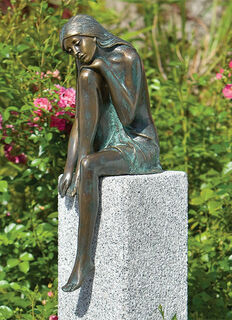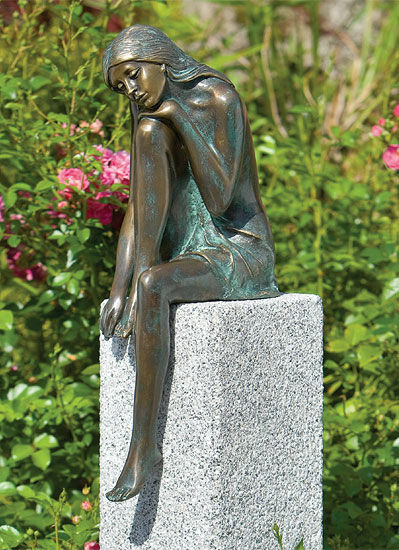Quick info
bronze | size 12 x 40 x 18 cm (w/h/d) | weight approx. 3 kg
Detailed description
Garden sculpture "Emanuelle" (version without stele)
"Emanuelle" sits relaxed in the garden and enjoys the warm sunshine. She can sit on a granite stele or (without a stele) on a garden bench or stone wall.
Sculpture made of cast bronze, handcrafted in the traditional Lost-Wax-Process and finished with a protective patina. Size 12 x 40 x 18 cm (w/h/d), weight approx. 3 kg. Without stele.
Customer reviews
Gut gearbeitet wie alle Produkte, die ich bisher bei ars mundi erworben habe. Emanuelle entspricht wieder voll meinen Erwartungen.
Es ist eine wunderschöne Skulptur. Ein Highlight im Garten!
prompte und zuverlässige Lieferung. Ich bin sehr zufrieden mit der Ausführung und Qualität der Skulptur !!
An alloy of copper with other metals (especially with tin) used since ancient times.
When casting bronze, the artist usually applies the lost-wax technique which is dating back more than 5000 years. It's the best, but also the most complex method of producing sculptures.
First, the artist forms a model of his sculpture. It is embedded in a liquid silicone rubber mass. Once the material has solidified, the model is cut out. The liquid wax is poured into the negative mould. After cooling down, the wax cast is removed from the mould, provided with sprues and dipped into ceramic mass. The ceramic mass is hardened in a kiln, whereby the wax flows out (lost mould).
Now we finally have the negative form, into which the 1400° C hot molten bronze is poured. After the bronze had cooled down, the ceramic shell is broken off and the sculpture is revealed.
Now the sprues are removed, the surfaces are polished, patinated and numbered by the artist himself or, to his specifications, by a specialist. Thus, each casting becomes an original work.
For lower-quality bronze castings, the sand casting method is often used which, however, does not achieve the results of a more complex lost-wax technique in terms of surface characteristics and quality.
A plastic work of sculptural art made of wood, stone, ivory, bronze or other metals.
While sculptures from wood, ivory or stone are made directly from the block of material, in bronze casting a working model is prepared at first. Usually, it is made of clay or other easily mouldable materials.
The prime time of sculpture after the Greek and Roman antiquity was the Renaissance. Impressionism gave a new impulse to the sculptural arts. Contemporary artists such as Jorg Immendorf, Andora, and Markus Lupertz also enriched sculptures with outstanding works.


